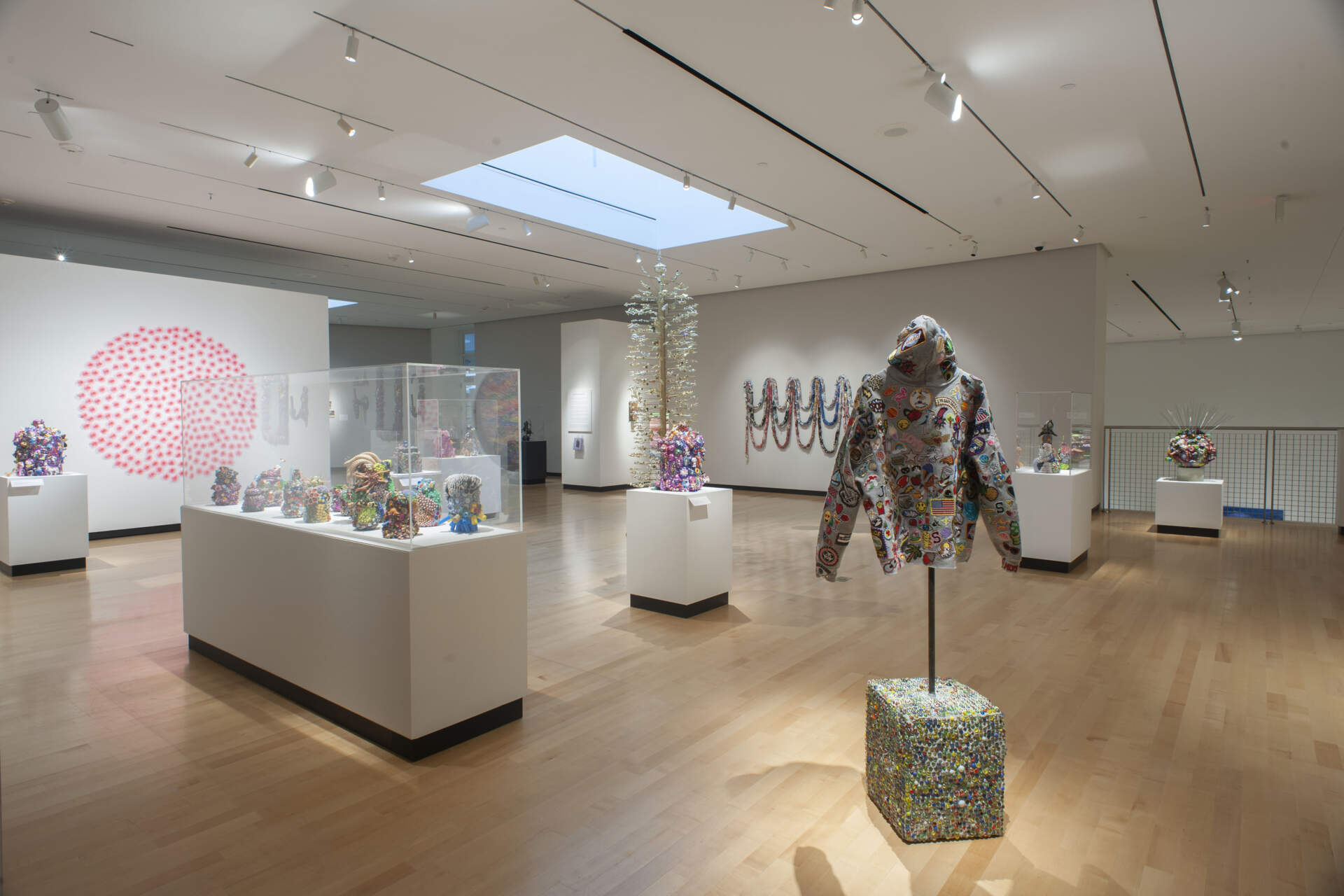
Ani Hoover: Forget-Me-Not Installation
Ani Hoover: Forget-Me-Not
Past
Oct 9, 2020 - Jun 27, 2021
Multi-media artist Ani Hoover creates uniquely meaningful artworks that connect with people because they resonate both personal and universal memories. In the past few years, she has used recycled and unconventional materials in her fiber work, sculpture, and installations. Growing up, Ani observed her grandmother’s crafting abilities, reading pattern books, and making things; but it wasn’t until after her grandmother passed that Ani decided to teach herself some of these craft arts. Over the years, she developed work with more global resonance in respect to connectivity. She pays homage to time-honored techniques of artisanship by producing artworks that are sculpted, collaged, assembled, embellished, sewn, crocheted, quilted, and woven. Their complexity, scale, and unusual source materials provide a fresh perspective.
Ani’s memory jars literally turn the insides out—their surfaces are encrusted with buttons, tiny toys, jewelry, and a plethora of small manufactured items. In all these works, she conjures up memories while inviting us to discard any previous expectations of what these traditional crafts can become. She also pays homage to the African and African American traditions in creating memory jugs covered with shells, shards of glass and ceramics, and other fragments. Other cultures have their versions, such as the centuries-old Japanese tradition of “kintsugi” in which broken ceramics are mended with gold, thus transforming them into uniquely beautiful objects that embrace life’s imperfections in a reverent combination of old and new. She parallels both cultures’ use of gold to elevate meaning by using glitter, but her sparkly work conveys a bifurcated focus on sentimental ideology and social critique.
The Forget-Me-Not exhibition features Hoover's newest creations. While last year’s Cookie Memory Jar was encrusted with many items of personal significance, Ani’s new series of memory-jugged objects are comprised of vessels and home accessories covered with small found objects, including toys, beads, costume jewelry, buttons, googly eyes, badminton birdies, festive light bulbs, and miniature representations of food, among so much more. She bought some second-hand; others were donated to her. One group of works is slathered in iridescent glitter and shiny, jewel-like spangles. In another group, she replaced Apoxie Sculpt with thin-set mortar stained in different colors and applied in crazy quilt-shaped sections, coated less chaotically with related mini-collections.
The most numerous applied items, made of brightly colored plastic or artificial material, feature pop culture figurines and animals marketing the latest fictional film or television characters. As quickly as they are adopted, a new season’s icons take their place to feed an endless cycle of impulsive acquisition and quick abandonment. The sheer volume perplexes Ani: “These objects were important to people at one time, but then they were thrown away.” People who wax nostalgic in recognition of an object they used to own may be missing the point of her implied commentary on our throwaway society. It begs the question: What legacy of insatiable consumption and pollution are we encouraging in our children?
The exhibition also includes works made of recycled materials for purely aesthetic purposes, like her wall-hung beaded circles that suggest a contemporary take on Impressionist painting: think Monet’s lush flower garden seen through a twenty-first-century lens. Her installations, such as Bloom, made of puffs of pink tulle, make us appreciate her own take on nature reimagined. Memory Sweatshirt is her most personal artwork. Literally, her father’s sweatshirt that she has adorned with embroidered patches and badges, embodies strongly felt emotions years after he passed. It signifies the power of things from everyday life to become vital symbols through reflective associations.
+Ani has always been oriented to the tactile quality of objects. Intriguing surfaces foster the impulse to touch. Fabric clothing comes in direct contact with skin. Fiber is sensuous and malleable. Vessels contain things, both visible and obscured. The language of tactility is her way to stay close to memories through the objects she transforms. “In a nutshell—the projects or crafts I chose to work on are about connections. Not just my connections to my past, but for others to connect too.” Her newest body of work manifests her artistic drive and feeds her penchant for experimentation. Her extraordinary ideas and abilities are why Ani Hoover was selected in 2019 to be awarded the Langley H. Kenzie Award for this 2020 solo exhibition.
The Langley H. Kenzie Award was created to honor Mrs. Kenzie’s dedication as an artist and to celebrate her support of others like her. It recognizes an outstanding artist from the biennial, juried exhibition, Art in Craft Media, by granting the recipient a solo exhibition in the following year. The award is supported by the Langley H. Kenzie Award Endowment, established by her daughters, Rachel King and Mary Kenzie. Past recipients of the Langley H. Kenzie Award include Bethany Krull (2010), Karen Donnellan (2012), Jesse Walp (2014), Jozef Bajus (2016) and Anne Currier (2018). The exhibition is fittingly presented in the Sylvia L. Rosen Gallery for Fine Art in Craft Media, named for the Burchfield Penney Art Center’s patron whose generous support makes possible the biennial exhibition, as well as collection development. The artist and Burchfield Penney staff and board are grateful for the support our patrons have provided to make this exhibition possible.
—Nancy Weekly, Burchfield Scholar, Head of Collections & Charles Cary Rumsey Curator and Burchfield Penney Instructor of Museum Studies, Burchfield Penney Art Center, SUNY Buffalo State.
Explore a self-guided virtual tour of the exhibition here.